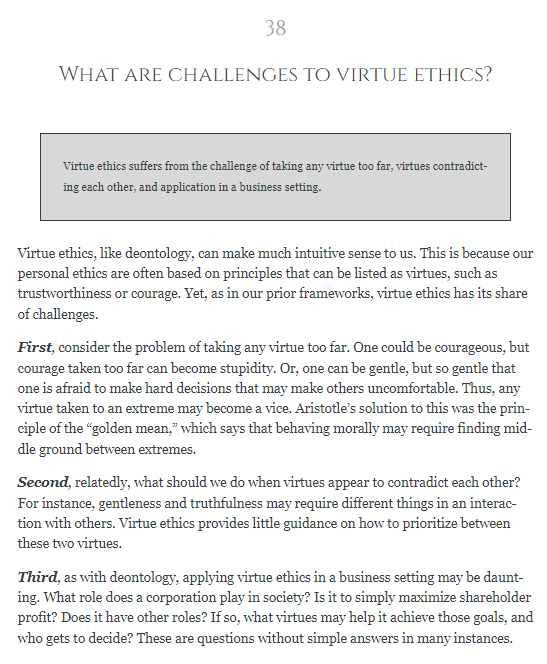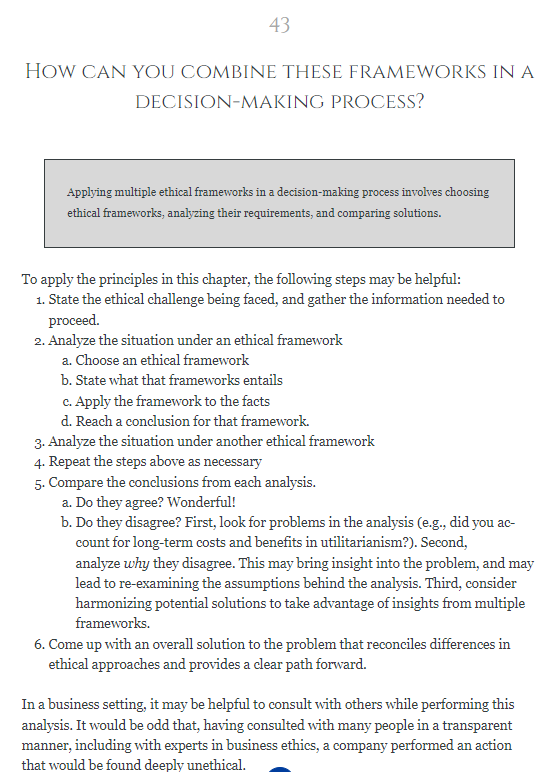

[38]
1. Consider the trolley problem and its related organ transplant problem in light of virtue ethics. What are your conclusions?
[43]
1. XYZ Motor Corporation begins to get customer complaints about two models of its automobiles. Customers have had near-death experiences from sudden acceleration; they would be driving along a highway at normal speed when suddenly the car would begin to accelerate, and efforts to stop the acceleration by braking fail to work. Drivers could turn off the ignition and come to a safe stop, but XYZ does not instruct buyers of its cars to do so, nor is this a common reaction among drivers who experience sudden acceleration. Internal investigations of half a dozen accidents in US locations come to the conclusion that the accidents are not being caused by drivers who mistake the gas pedal for the brake pedal. In fact, there appears to be a possible flaw in both models, perhaps in a semiconductor chip, that makes sudden acceleration happen. Interference by floor mats and poorly designed gas pedals do not seem to be the problem.
It is voluntary to report these incidents to the National Highway Traffic and Safety Administration (NHTSA), but the company decides that it will wait awhile and see if there are more complaints. Recalling the two models so that local dealers and their mechanics could examine them is also an option, but it would be extremely costly. Company executives are aware
that quarterly and annual profit-and-loss statements, on which their bonuses depend, could be decisively worse with a recall. They decide that on a cost-benefit basis, it makes more sense to wait until there are more accidents and more data. After a hundred or more accidents and nearly fifteen fatalities, the company institutes a selective recall, still not notifying NHTSA, which has its own experts and the authority to order XYZ to do a full recall of all affected models. Experts have advised XYZ that standard failure-analysis methodology requires that the company obtain absolutely every XYZ vehicle that has experienced sudden acceleration, using microscopic analysis of all critical components of the electronic system. The company does not wish to take that advice, as it would be—as one top executive put it—“too time-consuming and expensive.”
WHAT ARE CHALLENGES TO VIRTUE ETHICS? Virtue ethics suffers from the challenge of taking any virtue too far, virtues contradicting each other, and application in a business setting. Virtue ethics, like deontology, can make much intuitive sense to us. This is because our personal ethics are often based on principles that can be listed as virtues, such as trustworthiness or courage. Yet, as in our prior frameworks, virtue ethics has its share of challenges. First, consider the problem of taking any virtue too far. One could be courageous, but courage taken too far can become stupidity. Or, one can be gentle, but so gentle that one is afraid to make hard decisions that may make others uncomfortable. Thus, any virtue taken to an extreme may become a vice. Aristotle's solution to this was the principle of the "golden mean," which says that behaving morally may require finding middle ground between extremes. Second, relatedly, what should we do when virtues appear to contradict each other? For instance, gentleness and truthfulness may require different things in an interaction with others. Virtue ethics provides little guidance on how to prioritize between these two virtues. Third, as with deontology, applying virtue ethics in a business setting may be daunting. What role does a corporation play in society? Is it to simply maximize shareholder profit? Does it have other roles? If so, what virtues may help it achieve those goals, and who gets to decide? These are questions without simple answers in many instances.
HOW CAN YOU COMBINE THESE FRAMEWORKS IN A DECISION-MAKING PROCESS? Applying multiple ethical frameworks in a decision-making process involves choosing ethical frameworks, analyzing their requirements, and comparing solutions. To apply the principles in this chapter, the following steps may be helpful: 1. State the ethical challenge being faced, and gather the information needed to proceed. 2. Analyze the situation under an ethical framework a. Choose an ethical framework b. State what that frameworks entails c. Apply the framework to the facts d. Reach a conclusion for that framework. 3. Analyze the situation under another ethical framework 4. Repeat the steps above as necessary 5. Compare the conclusions from each analysis. a. Do they agree? Wonderful! b. Do they disagree? First, look for problems in the analysis (e.g., did you account for long-term costs and benefits in utilitarianism?). Second, analyze why they disagree. This may bring insight into the problem, and may lead to re-examining the assumptions behind the analysis. Third, consider harmonizing potential solutions to take advantage of insights from multiple frameworks. 6. Come up with an overall solution to the problem that reconciles differences in ethical approaches and provides a clear path forward. In a business setting, it may be helpful to consult with others while performing this analysis. It would be odd that, having consulted with many people in a transparent manner, including with experts in business ethics, a company performed an action that would be found deeply unethical.

